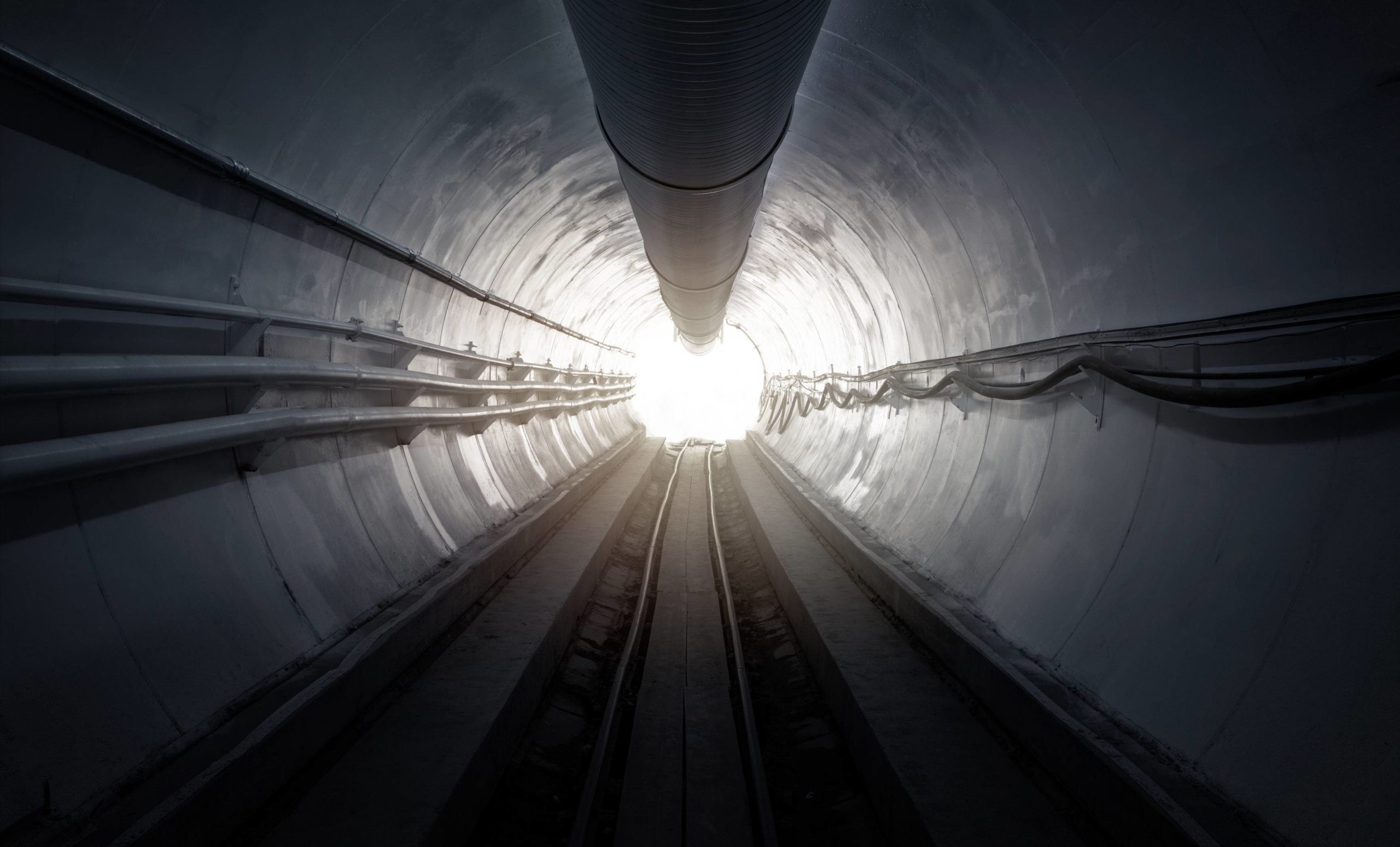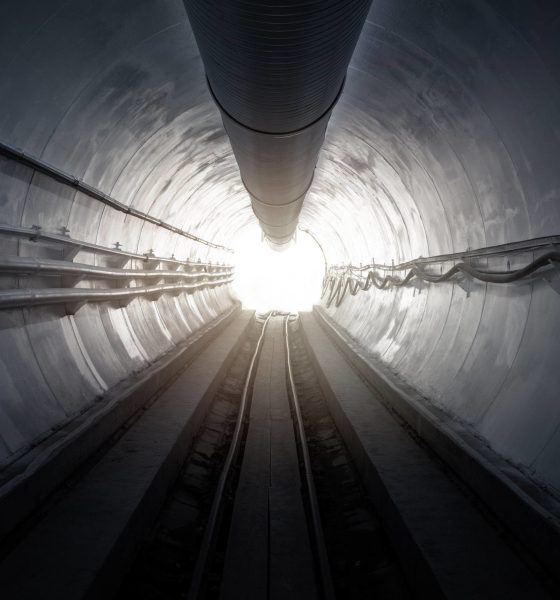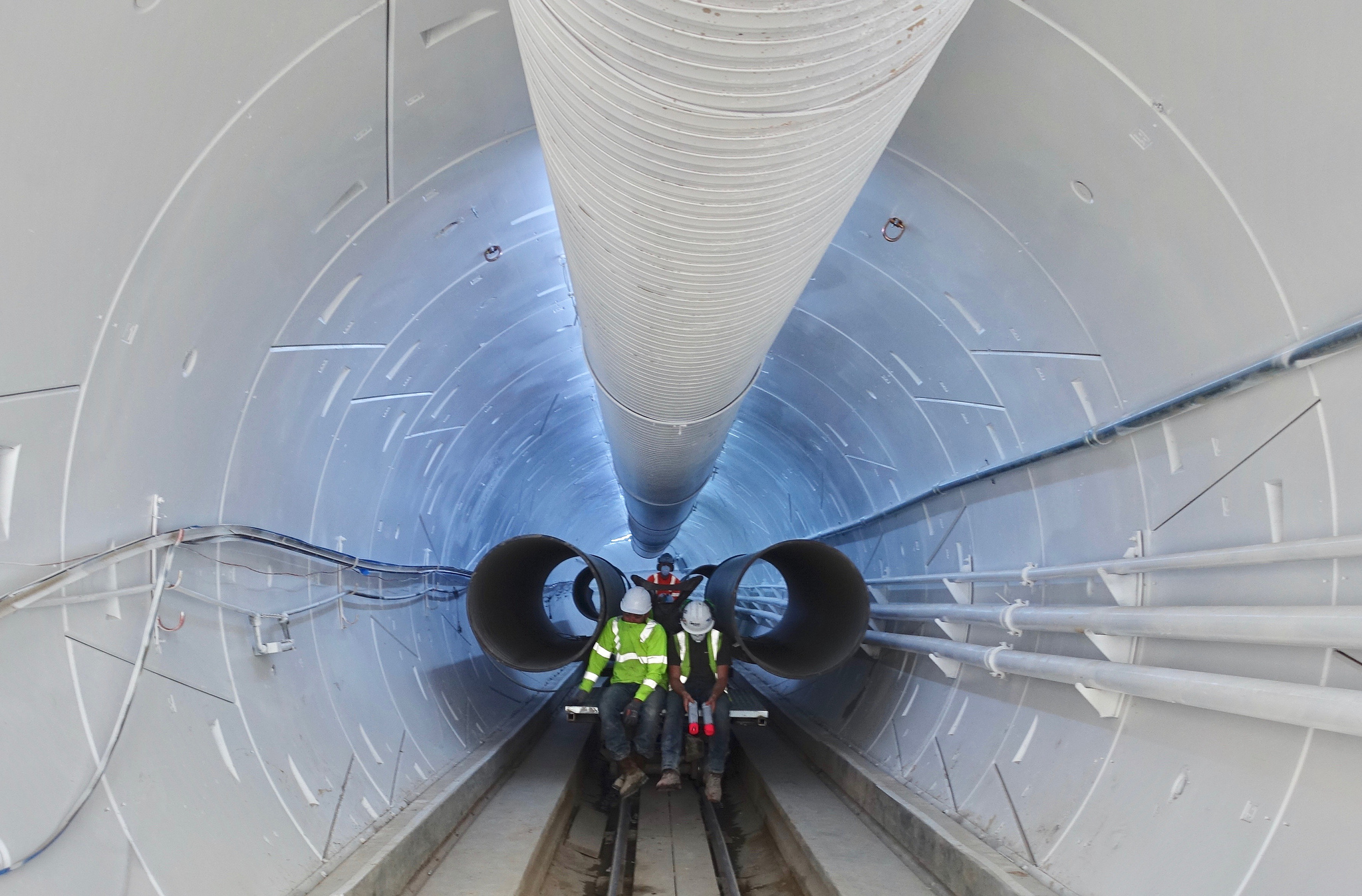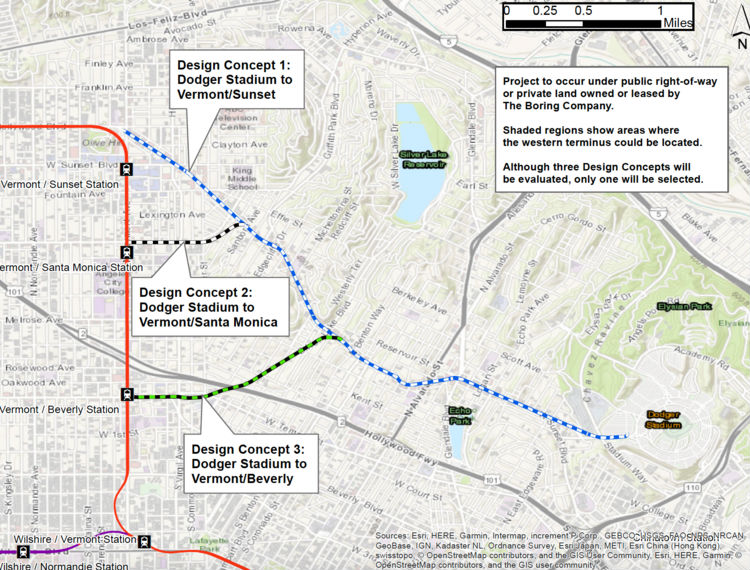

News
Why The Boring Company’s $10 million dollars per mile price tag is a game changer
With The Boring Company, Elon Musk hopes to overcome the pitfalls that drive up the costs of underground rail transport construction using good old-fashioned innovation with a dash of Silicon Valley startup dust (dirt?). Currently, most U.S. local and state governments (i.e., tax payers) hand over an average of $200-$500 million dollars per mile to construct a subway system, with hundreds of millions more per mile a common occurrence and even a $1 billion dollars per mile price tag having happened a few times already. The reasons for such expense seems to be multi-faceted and stubborn: regulations, unions, and project management. So, when the Tesla CEO and Boring Company founder cited $10 million dollars as the final price of their mile-long demonstration tunnel, including internal infrastructure, lighting, comms/video, safety systems, ventilation, and tracks, he seemed to be threatening to completely upend yet another industry, this one having been at the core of transportation for nearly 200 years.
“I like trains, by the way. I really like trains a lot,” Musk assured his press audience at the company’s recent demonstration tunnel opening event. The Boring Company (TBC) began as a Twitter discussion wherein the tech mogul was venting about “soul-destroying” traffic in Los Angeles. A concept animation followed soon after (as well as hats and not-a-flamethrowers), imagining a transportation system where cars would be shuttled around at high speeds underground on electric skates. Ideas flowed, tunneling began, and the result of all those efforts went on display December 18, 2018, demo rides included. A rideable 1.14 mile tunnel had been constructed from Crenshaw Boulevard across from the Hawthorne, California headquarters of SpaceX, Musk’s private rocket company, to the 120th Street/Prairie Avenue crossroad of Hawthorne.
Around this time last year, Brian Rosenthal of the New York Times exposed several astonishing factors that added up to a $3.5 billion dollars per mile cost to construct a 3.5 mile tunnel to connect Grand Central Terminal to the Long Island Rail Road in New York City, aka the “East Side Access”. An infamous “first”, this price tag is 7 times more than the average of anywhere else in the world. A combination of trade union, construction company, and consulting firm practices, including significant staff redundancy, bred an environment ripe for cost pile-ups, and both incompetence and the lack of oversight within New York’s Metropolitan Transportation Authority (MTA) added significantly to the issue. While the specific amount of money spent made the system’s cost unique in the world, the general underlying issues were not uncommon.

New York may be an exception to the already high-cost of rail construction rule, but there’s the rub: It’s already incredibly expensive. As documented in numerous articles by Alon Levy, an independent journalist whose 2011 blog post on the topic inspired the research that eventually led to the Times piece, $100-$500 million dollars per mile is a typical cost for building railed transporation worldwide. “These are crazy numbers,” Musk exclaimed at the tunnel opening event after summarizing the multiple billions of dollars short tunneling projects cost to complete in L.A. and New York. If the building cost wasn’t enough sticker shock, it gets worse: The daily operating costs of rail systems in the U.S. exceed the amount earned.
Another metric that is used to estimate the true cost of rail construction is cost per rider. After the time and money is spent building a public rail system, it needs to be staffed and repaired, expenses which are difficult to match with revenue without a large number of riders. As cited by Alon Levy in an article Elon Musk tweeted recently, New York’s Second Avenue Subway will cost $25,000 per rider to complete 200,000 trips per day. In Los Angeles, the Purple Line will cost $45,000 per rider for 150,000 trips per day as will Boston’s Green Line Extension for 52,000 trips. Looking at rider fares, New York loses a bit less than $1 per ride taken and L.A. loses over $2 per ride.
So, how will The Boring Company “do” underground transportation system building better than the traditional, money-heavy methods? To put it simply: Be efficient.
Building a better mouse snail trap
They’ve designed their tunneling machines to bore faster and more efficiently. While the first generation machine is conventional and named Godot after the Samuel Backett play, Waiting for Godot due to the length of time it took to understand the machine’s functionality and assemble it, two other improved generations will be part of the Boring family.
The second generation machine, named “Line-Storm” after a Robert Frost love poem with the same phrase in its title that’s about overcoming hardships, is a conventional boring machine that has been highly modified. It uses a redesigned cutting head that takes in significantly more dirt and is 2 times faster than Godot.
The third generation machine, named “Prufrock”, will be a ground-up, fully designed TBC machine that’s 15 times better than the next best boring system, and that means 15 times faster than the next best machine out there, period.
Improved construction practices and project management
During construction, TBC reinforced tunnel segments as they were dug, those reinforcements being created on-site out of materials comprising 70% of the dirt dug and the remaining 30% primarily cement. This recycled material, as-you-go system enabled quick construction with cost efficiency, the demo tunnel taking 2 years almost to the day from Musk’s initial Tweet that inspired the undertaking.
Function-focused engineering
TBC’s tunnels are smaller than the typical underground rail system because they’re designed for specific types of vehicles that are smaller than traditional transports (autonomous electrics) and don’t require extra space for maintenance. This in itself reduces costs by 3-4 times.
Although The Boring Company has the advantage of being the new kid on the block whose founder has a unique background in shaking up traditional systems, there may still be a few hangups that will never quite go away. Anything involving the general public, especially public transit, will have serious bureaucracy involved. To achieve the company’s mile-long demo track feat, it had to face the extreme regulatory environment of Los Angeles. California overall has earthquakes, is a methane zone, and has oil and gas fields, all which add to a long list of rules to be followed for any construction projects to commence. “The amount of paperwork we had to go through to do this was enormous,” Musk said at TBC’s recent event.

Additionally, a lawsuit filed last year by the Brentwood Residents Coalition and the Sunset Coalition objecting to the company’s Sepulveda tunnel eventually led to their abandonment of that leg of the demonstration project. The coalitions primarily alleged that TBC was skirting environmental review requirements by “chopping large projects into smaller pieces that taken individually appear to have no significant environmental impacts”, citing a conceptual map the company released showing its planned Los Angeles tunnel system. Musk hasn’t let these hurdles damage his confidence, however. While speaking with press at TBC’s opening event, he added his own spin to the Broadway mantra (and Frank Sinatra hit, “New York, New York”) about “making it” there : “If you can build a tunnel in L.A., you can build it anywhere.”
As CEO of an innovative electric car company and a commercial rocket company set on sending humans to Mars, Musk is known as an industry disruptor. Even if the cost of boring tunnels for public transportation projects rises somewhat above the $10 million per mile price demonstrated with the LA/Hawthorne tunnel, it will be still be well under the typical costs in the boring industry. It’s obvious already that a potential disruption is underway. “We have people hounding us to invest nonstop…it’s kinda ridiculous how much interest we’ve had in investing in Boring Company,” Musk stated at the tunnel unveiling. Steve Davis, president of the company, added that they receive “greater than 5 and less than 20 requests per week from different municipalities and stakeholders.”
Also in the works for the tunneling newcomers: A transport line connecting downtown Chicago to Chicago O’Hare International Airport. The company won a contract to build a transport system for the city’s fliers in June 2017, and ground breaking is planned for sometime in the next few months. The Boring Company’s calendar still includes plans for an “urban loop system” as well, an underground network of pod-type buses for pedestrians and cyclists connecting numerous points throughout city centers.

News
Tesla hints at Starlink integration with recent patent
“By employing polymer blends, some examples enable RF transmission from all the modules to satellites and other communication devices both inside and outside the vehicle.”

Tesla hinted at a potential Starlink internet terminal integration within its vehicles in a recent patent, which describes a vehicle roof assembly with integrated radio frequency (RF) transparency.
The patent, which is Pub. No U.S. 2025/0368267 describes a new vehicle roof that is made of RF-transparent polymer materials, allowing and “facilitating clear communication with external devices and satellites.”
Tesla believes that a new vehicle roof design, comprised of different materials than the standard metallic or glass elements used in cars today, would allow the company to integrate modern vehicular technologies, “particularly those requiring radio frequency transmission and reception.
Tesla has recently filed a US patent application on integrating RF transparent materials into the roof structure.
“facilitating clear communication with external devices and satellites”
Tesla fleet is getting @Starlink connectivity integration soon. LFG @Tesla @elonmusk… pic.twitter.com/bLa8YtPLd1
— Chansoo Byeon (@Chansoo) December 9, 2025
Instead of glass or metallic materials, Tesla says vehicles may benefit from high-strength polymer blends, such as Polycarbonate, Acrylonitrile Butadiene Styrene, or Acrylonitrile Styrene Acrylate.
These materials still provide ideal strength metrics for crashworthiness, stiffness for noise, vibration, and harshness control, and are compliant with head impact regulations.
They would also enable better performance with modern technologies, like internet terminals, which need an uninterrupted signal to satellites for maximum reception. Tesla writes in the patent:
“By employing polymer blends, some examples enable RF transmission from all the modules to satellites and other communication devices both inside and outside the vehicle.”

One of the challenges Tesla seems to be aware of with this type of roof design is the fact that it will still have to enable safety and keep that at the forefront of the design. As you can see in the illustration above, Tesla plans to use four layers to increase safety and rigidity, while also combating noise and vibration.
It notes in the patent that disclosed examples still meet the safety requirements outlined in the Federal Motor Vehicle Safety Standards (FMVSS).
Starlink integrated directly into Tesla vehicles would be a considerable advantage for owners. It would come with a handful of distinct advantages.
Initially, the inclusion of Starlink would completely eliminate cellular dead zones, something that is an issue, especially in rural areas. Starlink would provide connectivity in these remote regions and would ensure uninterrupted service during road trips and off-grid adventures.
It could also be a critical addition for Robotaxi, as it is crucial to have solid and reliable connectivity for remote monitoring and fleet management.
Starlink’s growing constellation, thanks to SpaceX’s routine and frequent launch schedule, will provide secure, stable, and reliable internet connectivity for Tesla vehicles.
Although many owners have already mounted Starlink Mini dishes under their glass roofs for a similar experience, it may be integrated directly into Teslas in the coming years, either as an upgrade or a standard feature.
News
Tesla supplements Holiday Update by sneaking in new Full Self-Driving version
It seems Tesla was waiting for the Hardware 4 rollout, as it wanted to also deploy a new Full Self-Driving version to those owners, as it appeared in the release notes for the Holiday Update last night.

Tesla has surprised some owners by sneaking in a new Full Self-Driving version with the wide release of the Holiday Update, which started rolling out to Hardware 4 owners on Friday night.
Tesla has issued a controlled and very slow release pattern with the Holiday Update, which rolls out with Software Version 2025.44.25.5.
For the past two weeks, as it has rolled out to Hardware 3 and older Tesla owners, the company has kept its deployment of the new Software Version relatively controlled.
It seems Tesla was waiting for the Hardware 4 rollout, as it wanted to also deploy a new Full Self-Driving version to those owners, as it appeared in the release notes for the Holiday Update last night.
Tesla Full Self-Driving v14.2.1.25 made its first appearance last night to Hardware 4 owners who are members of the Early Access Program (EAP). It appears to be a slight refinement from FSD v14.2.1, which has been out for a couple of weeks.
Tesla v2025.44.25.5 Holiday update incoming
Also Full Self-Driving v14.2.1.25!!! pic.twitter.com/74D7S0UGXz
— TESLARATI (@Teslarati) December 13, 2025
Many owners welcome the new FSD version, us included, because we’ve been less than impressed with v14.2.1. We have experienced some minor regressions with v14.2.1, especially with Speed Limit recognition, Speed Profile tinkering, and parking performance.
As it stands, Full Self-Driving is still particularly impressive, but Tesla is evidently having an issue with some of the adjustments, as it is still refining some of the performance aspects of the suite. This is expected and normal with some updates, as not all of them are an improvement in all areas; we routinely see some things backtrack every once in a while.
This new FSD version is likely to take care of those things, but it also includes all of the awesome Holiday Update features, which include:
- Grok with Navigation Commands (Beta) – Grok will now add and edit destinations.
- Tesla Photobooth – Take pictures inside your car using the cabin-facing camera
- Dog Mode Live Activity – Check on your four-legged friend on your phone through periodic snapshots taken of the cabin
- Dashcam Viewer Update – Includes new metrics, like steering wheel angle, speed, and more
- Santa Mode – New graphics, trees, and a lock chime
- Light Show Update – Addition of Jingle Rush light show
- Custom Wraps and License Plates – Colorizer now allows you to customize your vehicle even further, with custom patterns, license plates, and tint
- Navigation Improvements – Easier layout and setup
- Supercharger Site Map – Starting at 18 pilot locations, a 3D view of the Supercharger you’re visiting will be available
- Automatic Carpool Lane Routing – Navigation will utilize carpool lanes if enabled
- Phone Left Behind Chime – Your car will now tell you if you left a phone inside
- Charge Limit Per Location – Set a charge limit for each location
- ISS Docking Simulator – New game
- Additional Improvements – Turn off wireless charging pad, Spotify improvements, Rainbow Rave Cave, Lock Sound TRON addition
Tesla also added two other things that were undocumented, like Charging Passport and information on USB drive storage to help with Dashcam.
Cybertruck
Tesla updates Cybertruck owners about key Powershare feature

Tesla is updating Cybertruck owners on its timeline of a massive feature that has yet to ship: Powershare with Powerwall.
Powershare is a bidirectional charging feature exclusive to Cybertruck, which allows the vehicle’s battery to act as a portable power source for homes, appliances, tools, other EVs, and more. It was announced in late 2023 as part of Tesla’s push into vehicle-to-everything energy sharing, and acting as a giant portable charger is the main advantage, as it can provide backup power during outages.
Cybertruck’s Powershare system supports both vehicle-to-load (V2L) and vehicle-to-home (V2H), making it flexible and well-rounded for a variety of applications.
However, even though the feature was promised with Cybertruck, it has yet to be shipped to vehicles. Tesla communicated with owners through email recently regarding Powershare with Powerwall, which essentially has the pickup act as an extended battery.
Powerwall discharge would be prioritized before tapping into the truck’s larger pack.
However, Tesla is still working on getting the feature out to owners, an email said:
“We’re writing to let you know that the Powershare with Powerwall feature is still in development and is now scheduled for release in mid-2026.
This new release date gives us additional time to design and test this feature, ensuring its ability to communicate and optimize energy sharing between your vehicle and many configurations and generations of Powerwall. We are also using this time to develop additional Powershare features that will help us continue to accelerate the world’s transition to sustainable energy.”
Owners have expressed some real disappointment in Tesla’s continuous delays in releasing the feature, as it was expected to be released by late 2024, but now has been pushed back several times to mid-2026, according to the email.
Foundation Series Cybertruck buyers paid extra, expecting the feature to be rolled out with their vehicle upon pickup.
Cybertruck’s Lead Engineer, Wes Morrill, even commented on the holdup:
As a Cybertruck owner who also has Powerwall, I empathize with the disappointed comments.
To their credit, the team has delivered powershare functionality to Cybertruck customers who otherwise have no backup with development of the powershare gateway. As well as those with solar…
— Wes (@wmorrill3) December 12, 2025
He said that “it turned out to be much harder than anticipated to make powershare work seamlessly with existing Powerwalls through existing wall connectors. Two grid-forming devices need to negotiate who will form and who will follow, depending on the state of charge of each, and they need to do this without a network and through multiple generations of hardware, and test and validate this process through rigorous certifications to ensure grid safety.”
It’s nice to see the transparency, but it is justified for some Cybertruck owners to feel like they’ve been bait-and-switched.








